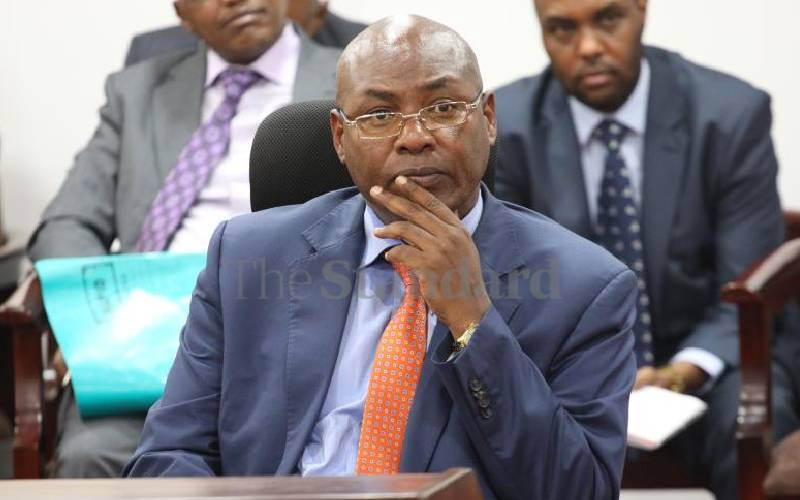Kenya: Three senior Ministry of Energy and Finance officials could have engineered a deal where the Government lost more than Sh1 billion.
The deal saw Essar Energy Overseas of India take up a 50 per cent stake in the Kenya Petroleum Refinery Ltd (KPRL). The Public Investments Committee (PIC) of Parliament, in a report, says senior officials at the Treasury, Ministry of Energy and KPRL were negligent in handling the process that may have cost the taxpayer upwards of Sh1 billion.
The Parliamentary watchdog committee, in a report, recommends the three officials be investigated by the Ethics and Anti-Corruption Commission (EACC). PIC claims former Energy PS Patrick Nyoike, Investment Secretary Esther Koimett and former refinery chief executive officer and current Taita Taveta governor John Mruttu, misled the Government to enter into an agreement with Essar that could have resulted in Kenya losing substantial amounts of money. This they did this without considering the numerous scenarios that would have played out during the lifetime of the partnership including the exit of the Indian firm where the government is greatly disadvantaged.
“The EACC should investigate the circumstances under which the Cabinet decision for the modernisation and refurbishment of the refinery was ignored and officers who flouted the Cabinet decision should be held accountable,” says PIC in Special Report on the restructuring of Kenya Petroleum Refinery Ltd report date April 29.
“The officers who participated in the negotiations, drafting and signing of the share agreement (the then Permanent Secretary, ministry of Energy, the Investment Secretary and the then Chief Executive Officer, KPRL and current governor for Taita Taveta County) be investigated for engineering the negotiations, drafting and signing of a skewed shareholder agreement in favour of Essar Energy Overseas Limited.”
The MPs say the EACC should investigate circumstances under which the consideration payable to the Government for waiver of its pre-emptive rights was reduced from the initial $15 million (Sh1.3 billion) to $2 million (Sh174 million) and was not paid in time and was drawn to a wrong payee by Essar Energy Overseas Ltd.
Even after short-changing the Government in reducing the goodwill from $15 million to $2 million, the cheque from Essar Energy to pay the Government was oscillating between Treasury and KPRL for two years and was eventually returned on claims it was drawn to the wrong payee (cheque kiting). “The Cheque was deliberately drawn to the wrong payee with the intention of creating delay and defrauding the Government of Kenya,” the Adan Keynan, led team established.
Also, the payment of the consideration fee of $2 million took long to be effected. It took two years, from July 2009 to March 2011, for Essar Energy Overseas to pay the goodwill amount yet the company was managing the Refinery two years before the payment of the goodwill amount.
“The money therefore paid as goodwill could have been generated by Essar from the refinery,” the committee noted.
Run down
The Government entered into a share agreement with Essar Energy Overseas Ltd on July 31, 2009 with the major objective of upgrading and modernising the refinery. The Agreement was signed to ensure the modernisation of the refinery to increase its crude handling capacity to four million tonnes a year and basically upgrade the refinery. The refinery has a capacity to process four million tonnes of crude but has been doing a dismal 1.6 million tonnes a year due to the run down equipment.
This has, however, not been realised yet Essar seeks to pull out of the refinery business. PIC says the exit clause in the share agreement between the Government and Essar was skewed in favour of the company to the extent that the Government would pay the company $5 million (Sh435 million) on exit from KPRL. Also, the Cabinet decision that modernisation be undertaken at the refinery was not adhered to by Essar. The Government agreed to the goodwill consideration on the understanding that Essar would undertake the modernisation of the refinery but this has never been undertaken by Essar thus breach of contract.
Also, there has been no financial audit of the company by the Audit-General Office despite being 50 per cent owned by the government.
Currently KPRL future is uncertain, having stopped operations last September and the government showing little interest in investing in the upgrade of the facility. The energy ministry has in the past said it has committed to invest Sh6.3 billion for a three per cent stake in the planned refinery in Uganda. There was a planned upgrade that would have cost of $1.2 billion (Sh103 billion) with the projected funding expected debt as well as investments by the two shareholders – Essar and government. It was scheduled for completion date was September 2018.
Stay informed. Subscribe to our newsletter
The three officials that PIC wants investigated however absolved themselves, telling the committee sitting that the deal was above board and with the best interests for the Kenyan economy. Former chief executive and now Taita Taveta governer Mruttu told PIC that before the deal to bring Essar on board was reached, a due diligence team comprising of ministry of Energy, Treasury, KPRL Board and management was sent to India to understand the capability of Essar.
He informed the committee that during the visit the team established that Essar had vast interest in oil, gas, coal, steel, shipping, horticulture and mobile telephony. He said the change in shareholding saw him (Mruttu) relinquish the position of CEO of KPRL and was made general manager. Essar had appointed Bimal Mukherjee as chief executive immediately after taking over and later Brij Bansal succeeded him. Bansal is to date the chief executive even as Essar plans to quit KPRL. Former PS Nyoike said the National Treasury had hired a private legal firm to assist in the negotiations and drafting of the agreements.
“I chaired all the negotiations, since they were held at the ministry of Energy in an open and transparent manner. The National Treasury was represented by Ms Esther Koimett, Investment Secretary and there was also a State Counsel from the State Law Office. The KPRL management was also in attendance to answer any questions on the operations of KPRL as a going business concern,” Nyoike said when he appeared before the committee.
“After conclusion of the negotiations, the approval and signing of the shareholders agreement was the responsibility of the National Treasury as the legal owner of the assets. In my view, we did the best we could in a fluid environment, given that the private shareholders were not prepared to spend any money on routine maintenance of the refinery.”
Value of company
On her part, Ms Koimett said Essar had come on board through buying a stake form private shareholders and as such Treasury was not involved in the transaction. Essar bought the 50 per cent stake from BP, Royal Dutch Shell and Chevron at $3 million and was to pay the government $2 million for the waiver of its pre-emptive rights to buy the stake from the three firms.
“The shares on offer belonged to private shareholders and their sale was between the private sector companies. The KPRL transaction was not a Government transaction. It was a sale and purchase of shares between private sector entities. As is the practice under Company Law, the transaction was governed by the Articles of Association of KPRL. In this respect, the process of transfer of shares was a preserve of the Board.”
She said the government was involved in the transaction purely on account of its interest, as the other 50 per cent shareholder in the joint venture through negotiation with the incoming shareholder (Essar) on the Shareholders’ Agreement and a technical services agreement. The Government (mainly the ministry of Energy) also negotiated a Government Support Agreement.
In order to forestall a situation where Essar would unnecessarily benefit from any growth in value of the company without having injected any capital, the Government required that Essar would only be entitled to a refund of the money paid by Essar for the 50 per cent shareholding from the existing shareholders, hence the $5 million.
“It was recognised that the value of the company and its assets was, even at the time of negotiations, substantially higher than the $5 million they paid for their 50 per cent stake. This was a very wise move by the Government to peg the exit price at the entry price of $5 million paid by Essar. As we would now be valuing the business assets of KPRL and paying Essar 50 per cent of the value,” said Ms Koimett.
 The Standard Group Plc is a
multi-media organization with investments in media platforms spanning newspaper
print operations, television, radio broadcasting, digital and online services. The
Standard Group is recognized as a leading multi-media house in Kenya with a key
influence in matters of national and international interest.
The Standard Group Plc is a
multi-media organization with investments in media platforms spanning newspaper
print operations, television, radio broadcasting, digital and online services. The
Standard Group is recognized as a leading multi-media house in Kenya with a key
influence in matters of national and international interest.
 The Standard Group Plc is a
multi-media organization with investments in media platforms spanning newspaper
print operations, television, radio broadcasting, digital and online services. The
Standard Group is recognized as a leading multi-media house in Kenya with a key
influence in matters of national and international interest.
The Standard Group Plc is a
multi-media organization with investments in media platforms spanning newspaper
print operations, television, radio broadcasting, digital and online services. The
Standard Group is recognized as a leading multi-media house in Kenya with a key
influence in matters of national and international interest.







